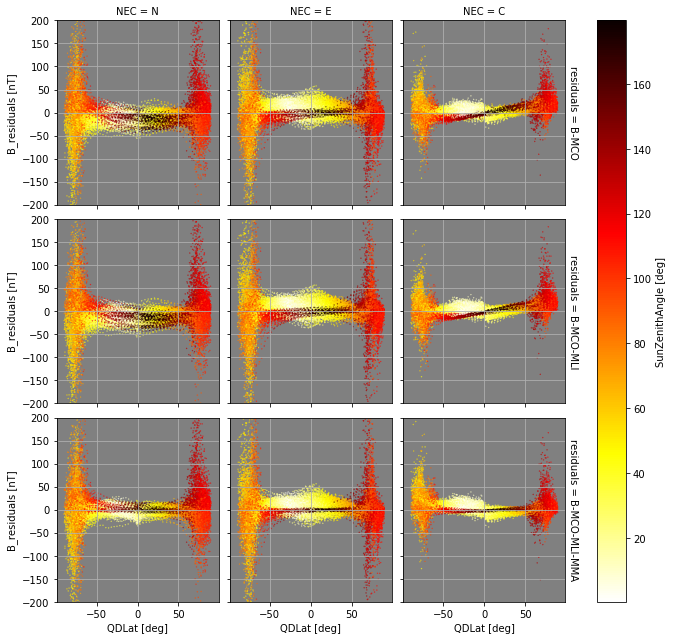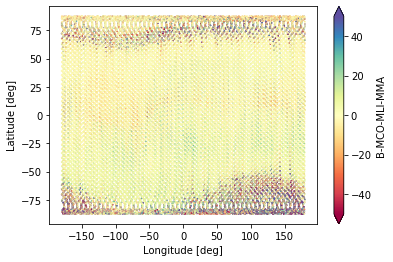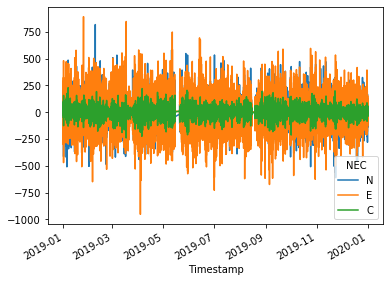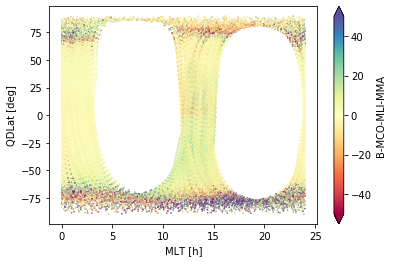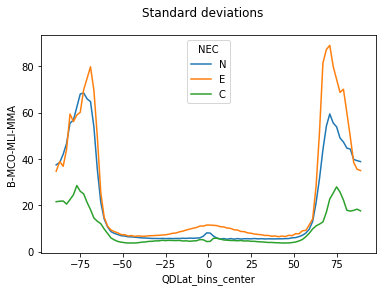Geomagnetic Model Residuals through VirES¶
Authors: Ashley Smith
Abstract: An exploration of geomagnetic data-model residuals evaluated through VirES (along Swarm orbits).
One day of residuals (data minus core field model)¶
<xarray.Dataset>
Dimensions: (NEC: 3, Timestamp: 86400)
Coordinates:
* Timestamp (Timestamp) datetime64[ns] 2019-01-01 ... 2019-01-01T23:59:59
* NEC (NEC) <U1 'N' 'E' 'C'
Data variables:
Spacecraft (Timestamp) object 'A' 'A' 'A' 'A' ... 'A' 'A' 'A' 'A'
Latitude (Timestamp) float64 -17.03 -16.97 -16.9 ... 44.0 43.93
QDLat (Timestamp) float64 -13.95 -13.89 ... 39.82 39.75
Radius (Timestamp) float64 6.819e+06 6.819e+06 ... 6.809e+06
B_NEC_res_CHAOS-Core (Timestamp, NEC) float64 -13.59 -18.73 ... 4.657 7.435
SunZenithAngle (Timestamp) float64 40.87 40.89 40.91 ... 141.1 141.2
Longitude (Timestamp) float64 -136.0 -136.0 ... 40.88 40.88
MLT (Timestamp) float64 14.8 14.8 14.8 ... 2.42 2.42 2.42
Attributes:
Sources: ['SW_OPER_MAGA_LR_1B_20190101T000000_20190101T235959_050...
MagneticModels: ["CHAOS-Core = 'CHAOS-Core'(max_degree=20,min_degree=1)"]
RangeFilters: []xarray provides some convenient direct plotting tools through integration with matplotlib:
/opt/conda/lib/python3.7/site-packages/pandas/plotting/_matplotlib/converter.py:103: FutureWarning: Using an implicitly registered datetime converter for a matplotlib plotting method. The converter was registered by pandas on import. Future versions of pandas will require you to explicitly register matplotlib converters.
To register the converters:
>>> from pandas.plotting import register_matplotlib_converters
>>> register_matplotlib_converters()
warnings.warn(msg, FutureWarning)
/opt/conda/lib/python3.7/site-packages/IPython/core/pylabtools.py:128: UserWarning: Creating legend with loc="best" can be slow with large amounts of data.
fig.canvas.print_figure(bytes_io, **kw)
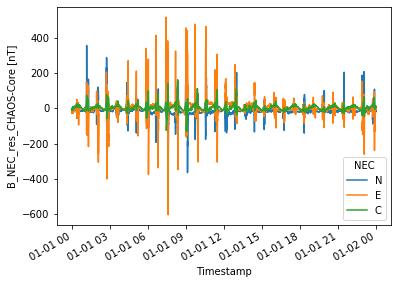
This allows some very compact plotting commands to create complex figures, if you know how! This kind of plotting takes a while to learn and experiment with to get right, but results in short and manageable code.

(showing that we are in daylight more in the Southern hemisphere, while in darkness in the Northern, because the data is from January - Northern winter)

(showing the rapid movement through local time sectors (MLT) when the satellite passes through polar regions)
The above figures show large residuals in the polar regions due to currents in the auroral oval. These cause greater disturbance in the Northward (N) and Eastward (E) components of the magnetic field because of the geometry of the field-aligned currents (FACs) which cause the magnetic disturbance.
Access 1 year of data and models at 1-minute sampling¶
Fetch the B_NEC vector from Swarm Alpha and all parts of the CHAOS model (core, crust, magnetosphere) evaluated at the same points. We also access MLT, QDLat, and SunZenithAngle which are also evaluated on-the-fly.
We fetch the model values themselves as well as the measurements (instead of just the residuals as above) so that we can manipulate all the different components locally.
We apply filters to remove bad data (according to Flags_F) and only select geomagnetically quiet data (according to Kp).
Warning: Takes several minutes to process
request = SwarmRequest()
request.set_collection("SW_OPER_MAGA_LR_1B")
request.set_products(
measurements=["B_NEC"],
models=["CHAOS-Core", "CHAOS-Static", "CHAOS-MMA-Primary", "CHAOS-MMA-Secondary"],
auxiliaries=["MLT", "QDLat", "SunZenithAngle", "OrbitNumber"],
sampling_step="PT60S")
request.set_range_filter("Flags_F", 0, 1)
request.set_range_filter("Kp", 0, 3)
# request.set_range_filter("SunZenithAngle", 100, 180)
data = request.get_between("2019-01-01", "2020-01-01")
ds = data.as_xarray()
ds
<xarray.Dataset>
Dimensions: (NEC: 3, Timestamp: 466712)
Coordinates:
* Timestamp (Timestamp) datetime64[ns] 2019-01-01 ... 2019-12-31T23:59:00
* NEC (NEC) <U1 'N' 'E' 'C'
Data variables:
Spacecraft (Timestamp) object 'A' 'A' 'A' ... 'A' 'A' 'A'
B_NEC_CHAOS-MMA-Primary (Timestamp, NEC) float64 -13.85 1.0 ... 7.753
Latitude (Timestamp) float64 -17.03 -13.18 ... 69.06 72.89
QDLat (Timestamp) float64 -13.95 -10.11 ... 64.82 68.43
B_NEC_CHAOS-Static (Timestamp, NEC) float64 -0.1243 1.575 ... 1.596
Radius (Timestamp) float64 6.819e+06 ... 6.803e+06
B_NEC_CHAOS-Core (Timestamp, NEC) float64 2.369e+04 ... 4.899e+04
SunZenithAngle (Timestamp) float64 40.87 42.22 ... 108.7 109.2
B_NEC_CHAOS-MMA-Secondary (Timestamp, NEC) float64 -0.303 0.9856 ... 1.593
B_NEC (Timestamp, NEC) float64 2.368e+04 ... 4.9e+04
Longitude (Timestamp) float64 -136.0 -136.1 ... 99.22 100.7
MLT (Timestamp) float64 14.8 14.76 ... 6.348 6.442
OrbitNumber (Timestamp) int32 28692 28692 ... 34324 34324
Attributes:
Sources: ['CHAOS-7_static.shc', 'SW_OPER_AUXAORBCNT_20131122T0000...
MagneticModels: ["CHAOS-Core = 'CHAOS-Core'(max_degree=20,min_degree=1)"...
RangeFilters: ['Flags_F:0,1', 'Kp:0,3']We can construct xarray.DataArray’s based on ds:
<xarray.DataArray 'B_NEC' (Timestamp: 466712, NEC: 3)>
array([[ 23675.6712, 5295.6287, -12248.4677],
[ 24198.5082, 4977.3795, -8959.3254],
[ 24573.8281, 4698.8367, -5597.6175],
...,
[ 7777.4566, 200.041 , 49057.4534],
[ 6013.2835, 276.402 , 49151.6042],
[ 4458.587 , 339.0241, 48998.7619]])
Coordinates:
* Timestamp (Timestamp) datetime64[ns] 2019-01-01 ... 2019-12-31T23:59:00
* NEC (NEC) <U1 'N' 'E' 'C'
Attributes:
units: nT
description: Magnetic field vector, NEC frame<xarray.DataArray (Timestamp: 466712, NEC: 3)>
array([[-13.59336441, -18.72677602, -1.03682201],
[-11.30811992, -26.74804476, -2.24978599],
[-10.70361885, -24.35533753, -11.05697668],
...,
[ -3.41565499, 1.08109483, 5.38467198],
[ 0.23614656, 4.04043334, 5.63352147],
[ -2.05132268, -0.85855007, 5.23094709]])
Coordinates:
* Timestamp (Timestamp) datetime64[ns] 2019-01-01 ... 2019-12-31T23:59:00
* NEC (NEC) <U1 'N' 'E' 'C'… and we can plot these directly:
We can slice out a particular time window:
<xarray.Dataset>
Dimensions: (NEC: 3, Timestamp: 2830)
Coordinates:
* Timestamp (Timestamp) datetime64[ns] 2019-01-01 ... 2019-01-02T23:59:00
* NEC (NEC) <U1 'N' 'E' 'C'
Data variables:
Spacecraft (Timestamp) object 'A' 'A' 'A' ... 'A' 'A' 'A'
B_NEC_CHAOS-MMA-Primary (Timestamp, NEC) float64 -13.85 1.0 ... -12.23
Latitude (Timestamp) float64 -17.03 -13.18 ... -74.84
QDLat (Timestamp) float64 -13.95 -10.11 ... -69.15
B_NEC_CHAOS-Static (Timestamp, NEC) float64 -0.1243 1.575 ... -1.676
Radius (Timestamp) float64 6.819e+06 ... 6.823e+06
B_NEC_CHAOS-Core (Timestamp, NEC) float64 2.369e+04 ... -4.541e+04
SunZenithAngle (Timestamp) float64 40.87 42.22 ... 57.18 54.47
B_NEC_CHAOS-MMA-Secondary (Timestamp, NEC) float64 -0.303 ... -0.2389
B_NEC (Timestamp, NEC) float64 2.368e+04 ... -4.543e+04
Longitude (Timestamp) float64 -136.0 -136.1 ... -147.5
MLT (Timestamp) float64 14.8 14.76 ... 17.34 16.84
OrbitNumber (Timestamp) int32 28692 28692 ... 28723 28723
Attributes:
Sources: ['CHAOS-7_static.shc', 'SW_OPER_AUXAORBCNT_20131122T0000...
MagneticModels: ["CHAOS-Core = 'CHAOS-Core'(max_degree=20,min_degree=1)"...
RangeFilters: ['Flags_F:0,1', 'Kp:0,3']… and subselect according to parts of the data:
<xarray.Dataset>
Dimensions: (NEC: 3, Timestamp: 181582)
Coordinates:
* Timestamp (Timestamp) datetime64[ns] 2019-01-01T00:23:00 ... 2019-12-31T23:59:00
* NEC (NEC) <U1 'N' 'E' 'C'
Data variables:
Spacecraft (Timestamp) object 'A' 'A' 'A' ... 'A' 'A' 'A'
B_NEC_CHAOS-MMA-Primary (Timestamp, NEC) float64 -0.6017 ... 7.753
Latitude (Timestamp) float64 71.57 75.39 ... 69.06 72.89
QDLat (Timestamp) float64 74.24 78.08 ... 64.82 68.43
B_NEC_CHAOS-Static (Timestamp, NEC) float64 -3.15 1.445 ... 1.596
Radius (Timestamp) float64 6.805e+06 ... 6.803e+06
B_NEC_CHAOS-Core (Timestamp, NEC) float64 5.359e+03 ... 4.899e+04
SunZenithAngle (Timestamp) float64 101.1 104.1 ... 108.7 109.2
B_NEC_CHAOS-MMA-Secondary (Timestamp, NEC) float64 1.172 0.2115 ... 1.593
B_NEC (Timestamp, NEC) float64 5.335e+03 ... 4.9e+04
Longitude (Timestamp) float64 -133.0 -131.0 ... 99.22 100.7
MLT (Timestamp) float64 13.64 13.4 ... 6.348 6.442
OrbitNumber (Timestamp) float64 2.869e+04 ... 3.432e+04
Attributes:
Sources: ['CHAOS-7_static.shc', 'SW_OPER_AUXAORBCNT_20131122T0000...
MagneticModels: ["CHAOS-Core = 'CHAOS-Core'(max_degree=20,min_degree=1)"...
RangeFilters: ['Flags_F:0,1', 'Kp:0,3']We can use the above to construct a plot based on part of the data
# Select one day
_ds = ds.sel({"Timestamp": slice("2019-01-01", "2019-01-02")})
# Select nightside data from it
_ds_dark = _ds.where(_ds["SunZenithAngle"] > 100, drop=True)
# Append a custom residual of B-MCO-MLI-MMA
_ds_dark["B_res_full"] = _ds_dark["B_NEC"] - _ds_dark["B_NEC_CHAOS-Core"] \
- _ds_dark["B_NEC_CHAOS-Static"] \
- _ds_dark["B_NEC_CHAOS-MMA-Primary"] \
- _ds_dark["B_NEC_CHAOS-MMA-Secondary"]
_ds_dark.plot.scatter(x="QDLat", y="B_res_full", hue="OrbitNumber", col="NEC",
cmap="viridis", s=0.2);

Plotting residuals to different model combinations from one month of data¶
First we adjust the Dataset so that it contains the custom residuals themselves. We store them as both regular data variables and as a higher dimensional "B_residuals" which includes all of them. This is inefficient but is convenient for the plotting tools used below.
def assign_residuals(ds):
# Work on a copy of the Dataset so we don't disturb the original
ds = ds.copy()
# Assign custom residual variables
ds["B-MCO"] = ds["B_NEC"] - ds["B_NEC_CHAOS-Core"]
ds["B-MCO-MLI"] = ds["B-MCO"] - ds["B_NEC_CHAOS-Static"]
ds["B-MCO-MLI-MMA"] = ds["B-MCO-MLI"] - ds["B_NEC_CHAOS-MMA-Primary"]\
- ds["B_NEC_CHAOS-MMA-Secondary"]
# Create a new DataArray to contain all these residual combinations
da = ds["B_NEC"].copy()
da.name = "B_residuals"
# Expand to 3 dimensions for each residual combination to use
da = da.expand_dims({"residuals": 3})
da.coords["residuals"] = ["B-MCO", "B-MCO-MLI", "B-MCO-MLI-MMA"]
# Assign the residual data to the DataArray
da = da.copy()
da.loc[{"residuals": "B-MCO"}] = ds["B-MCO"]
da.loc[{"residuals": "B-MCO-MLI"}] = ds["B-MCO-MLI"]
da.loc[{"residuals": "B-MCO-MLI-MMA"}] = ds["B-MCO-MLI-MMA"]
# Assign the new DataArray to the original Dataset
ds["B_residuals"] = da
return ds
ds = assign_residuals(ds)
ds
<xarray.Dataset>
Dimensions: (NEC: 3, Timestamp: 466712, residuals: 3)
Coordinates:
* Timestamp (Timestamp) datetime64[ns] 2019-01-01 ... 2019-12-31T23:59:00
* NEC (NEC) <U1 'N' 'E' 'C'
* residuals (residuals) <U13 'B-MCO' ... 'B-MCO-MLI-MMA'
Data variables:
Spacecraft (Timestamp) object 'A' 'A' 'A' ... 'A' 'A' 'A'
B_NEC_CHAOS-MMA-Primary (Timestamp, NEC) float64 -13.85 1.0 ... 7.753
Latitude (Timestamp) float64 -17.03 -13.18 ... 69.06 72.89
QDLat (Timestamp) float64 -13.95 -10.11 ... 64.82 68.43
B_NEC_CHAOS-Static (Timestamp, NEC) float64 -0.1243 1.575 ... 1.596
Radius (Timestamp) float64 6.819e+06 ... 6.803e+06
B_NEC_CHAOS-Core (Timestamp, NEC) float64 2.369e+04 ... 4.899e+04
SunZenithAngle (Timestamp) float64 40.87 42.22 ... 108.7 109.2
B_NEC_CHAOS-MMA-Secondary (Timestamp, NEC) float64 -0.303 0.9856 ... 1.593
B_NEC (Timestamp, NEC) float64 2.368e+04 ... 4.9e+04
Longitude (Timestamp) float64 -136.0 -136.1 ... 99.22 100.7
MLT (Timestamp) float64 14.8 14.76 ... 6.348 6.442
OrbitNumber (Timestamp) int32 28692 28692 ... 34324 34324
B-MCO (Timestamp, NEC) float64 -13.59 -18.73 ... 5.231
B-MCO-MLI (Timestamp, NEC) float64 -13.47 -20.3 ... 3.635
B-MCO-MLI-MMA (Timestamp, NEC) float64 0.6871 -22.29 ... -5.711
B_residuals (residuals, Timestamp, NEC) float64 -13.59 ... -5.711
Attributes:
Sources: ['CHAOS-7_static.shc', 'SW_OPER_AUXAORBCNT_20131122T0000...
MagneticModels: ["CHAOS-Core = 'CHAOS-Core'(max_degree=20,min_degree=1)"...
RangeFilters: ['Flags_F:0,1', 'Kp:0,3']Here we create scatter plots to show the data in different views. We select only the first month - this reduces the crowding on the figures but shows that we should seek different methods to produce summary views of the data for longer time periods.
facetgrid = (
ds.sel({"Timestamp": slice("2019-01-01", "2019-02-01")})
.plot.scatter(x="QDLat", y="B_residuals", col="NEC", row="residuals",
sharex="all", sharey="row", s=0.1,
hue="SunZenithAngle", cmap="hot_r"))
for ax in facetgrid.axes.flat:
ax.set_facecolor("grey")
ax.grid()
ax.set_ylim((-200, 200))
